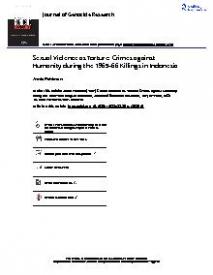Sexual Violence as Torture : Crimes against Humanity during the 1965–66 Killings in Indonesia
In this article, I argue that sexualized forms of torture perpetrated mainly against women and girls in political detention camps across Indonesia between 1965 and 1970 were crimes against humanity. To make this argument, I draw upon some key cases in international criminal case law regarding the prosecution of sexual violence as torture as crimes against humanity.
The prosecution of these cases is instructive for considering such crimes in the Indonesian case because they defined much of the gender jurisprudence for international crimes and because they were based on evidence given by women survivors. I contend that these sexualized forms of violence must be considered crimes against humanity because they were widespread and committed systematically against a civilian population. I argue that rape and other forms of sexual violence were perpetrated as torture in the detention camps that spread across Indonesia at that time. This violence, perpetrated primarily against women and girls, developed into a concerted, widespread strategy carried out systematically by the Indonesian military and its proxies.
Drawing on testimonial data mainly by women who experienced this violence, I outline patterns in this sexualized torture. I situate this discussion within the context of the recent International People’s Tribunal for 1965. As the investigator assisting the prosecutor on sexual crimes, I prepared evidence based on the testimonies of survivors and eyewitnesses.
The oral testimonies of mainly women survivors were used to prepare this evidence and were drawn mostly from the oral historical documentation projects carried out by Indonesian human rights organizations. At the end of the article, I use two of these testimonies, one by a woman and one by a man, to illustrate some of the overall patterns of sexual abuse as torture.
In: Journal of Genocide Research, ISSN 1462-3528 ; eISSN 1469-9494 | 19 | 4 | 574–593
https://doi.org/10.1080/14623528.2017.1393949
This is an Open Access article distributed under the terms of the Creative Commons Attribution License (http://creativecommons.org/


